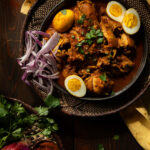Firew Konjo is a hand-loom textile artist from Ethiopia who has been exhibiting at IFAM (the International Folk Art Market Booth 1, Rooted in Community Neighborhood) since 2023. He has kindly shared his recipe for Doro Wat, a dish deeply rooted in Ethiopian culture and tradition. “Its significance lies not only in its rich flavor but also in its role in Ethiopian social and religious life,” he says. “It is often prepared as part of a feast for major holidays like Christmas and Fasika (Ethiopian Orthodox Easter).” Its complex flavors come from a unique blend of spices including berbere (a spice mix), as well as niter kibbeh (a spiced butter), and hard boiled eggs. “For many Ethiopians, Doro Wat is more than just food – it’s a symbol of hospitality, unity, and tradition.
What is Doro Wat?
This Doro Wat recipe makes a rich, spicy chicken stew that is a centerpiece of many Ethiopian celebrations, especially Ethiopian Orthodox Easter. As with many Ethiopian dishes, it benefits from slow cooking. The more time you give it, the richer and more flavorful the sauce will become. Enjoy making doro wat for a taste of Ethiopian culture and tradition at your table.
Print
Doro Wat
Description
A traditional Ethiopian Doro Wat recipe that you can try at home.
Ingredients
For the chicken:
- 2½ lb chicken (cut into pieces, bone-in, skin-on, including wings, thighs, drumsticks, and breast)
- 1 tbsp lemon juice
- 1 tsp salt
- ½ tsp ground ginger (optional, for marinating)
For the nitre kibbeh (spiced butter):
- 1 cup unsalted butter
- 1 small onion, finely chopped
- 1 cinnamon stick
- 3–4 whole cloves
- 3–4 cardamom pods
- 1 tsp ground ginger
- 2 garlic cloves, crushed
- 2 tsp ground turmeric
- 1 tbsp chopped fresh basil (optional)
For the doro wat sauce:
- 3 tbsp Nitre Kibbeh (or regular unsalted butter if you don’t have Nitre Kibbeh – see note)
- 3 large onions, finely chopped
- 2 tbsp minced garlic
- 1 tbsp minced fresh ginger
- 1 tbsp ground turmeric
- 3–4 tbsp Berbere (Ethiopian spice mix, adjust for heat preference – see note)
- 2 tbsp tomato paste
To prepare the chicken:
- 3 cups chicken broth or water
- 2 tbsp Kik Wot (or korerima—Ethiopian cardamom – optional for more spice complexity)
- 2–3 hard-boiled eggs (optional, but a traditional addition to Doro Wat)
- Salt, to taste
- Injera, Ethiopian flatbread or other flatbread
Instructions
For the chicken:
- In a large bowl, combine the chicken pieces with lemon juice, salt, and ground ginger.
- Mix well and let it marinate for at least 30 minutes (ideally for 2–3 hours or overnight in the refrigerator).
For the nitre kibbeh (spiced butter):
- In a small saucepan, melt the butter over medium heat.
- Add the chopped onions, cinnamon stick, cloves, cardamom pods, ginger, and garlic. Stir occasionally, cooking the mixture for about 10–12 minutes until the onions soften and caramelize, giving the butter a rich, aromatic flavor.
- Add the turmeric and cook for another 3–5 minutes. Once done, strain the spices if you want to remove them, or leave them in for a more robust flavor. Stir in the fresh basil if using.
- Set aside about 3 tablespoons of this Nitre Kibbeh for the sauce, and store the rest for later use.
For the doro wat sauce:
- Heat a large pot or Dutch oven over medium heat. Add 3 tbsp of Nitre Kibbeh (or regular butter if using), and heat it until melted.
- Add the chopped onions to the pot. Cook the onions slowly, stirring occasionally until they caramelize and soften — this can take about 20–30 minutes. The longer you cook the onions, the richer and deeper the flavor of the sauce will be.
- Once the onions are soft and golden brown, add minced garlic, minced ginger, and ground turmeric. Stir the mixture and cook for about 5 minutes.
- Stir in the berbere spice mix, and cook for another 5 minutes. The spices should bloom and become fragrant.
- Add the tomato paste and continue to cook for another 5–10 minutes until the tomato paste darkens and blends into the sauce.
To prepare the chicken:
- Add the marinated chicken pieces to the pot that contains the doro wat sauce. Stir to coat the chicken in the spice mixture.
- Add the chicken broth (or water) to the pot. Bring the mixture to a boil and then reduce the heat to low. Cover the pot and let the chicken simmer for 45 minutes to an hour, until the chicken is tender and the flavors have fully developed. Stir occasionally.
- If the sauce becomes too thick, add more chicken broth or water to achieve the desired consistency.
- While the chicken is cooking, you can prepare the hard-boiled eggs. Boil the eggs, peel them, and set them aside.
- About 10–15 minutes before the chicken is fully cooked, gently add the hard-boiled eggs to the pot. Let the eggs simmer in the sauce, soaking up the flavors.
- Taste the sauce and adjust the salt or berbere for more spice if necessary.
- Once the chicken is cooked and the sauce has thickened, remove the pot from the heat.
- Doro wat is traditionally served with injera, the spongy Ethiopian flatbread. To serve, place a few pieces of chicken and a hard-boiled egg on top of a large piece of injera. Pour the rich, spicy sauce over the top.
- Let everyone enjoy by using pieces of injera to scoop up the chicken and sauce — Ethiopian meals are often communal, and this is an important part of the tradition.
Notes
- The amount of berbere (Ethiopian spice mix) used can vary depending on how spicy you like your doro wat. If you’re sensitive to spice, you can use a smaller amount or substitute it with a milder spice mix.
- If you don’t wish to make the nitre kibbeh, you can substitute with regular clarified butter, but the flavor won’t be as aromatic or as rich.
Recipe by Firew Konjo
Styling by Anna Franklin
Photography by Dave Bryce
Subscribe to TABLE Magazine‘s print edition.
